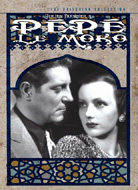Pépé le Moko
| Pépé le Moko is the film that made consummate French actor Jean Gabin a star. It was hardly his first role—he had already played in a dozen movies since 1930, and he would eventually star (that is, play the lead role) in dozens and dozens of films over his multi-decade career. Deviously handsome in an unconventional way, Gabin excelled at conveying confidence and authority, even when trapped in a fatalistic plot that would ensure his romantic demise by the film's final frames. Film theorist Andre Bazin referred to him quite rightly as "the tragic hero of contemporary cinema." It was in Pépé le Moko that he fully solidified that persona, starring as the titular French criminal who is hiding out in the Casbah section of French Algiers. Sought after by police in both Paris and Algiers, Pépé remains in complete control of his life, living in the wild, narrow, multiethnic streets of the Casbah like a lord, casually going about his business knowing that the police cannot take down a king in his own palace. Initially based on the gangsters of early American crime films like Scarface (1932), Pépé is nonetheless a unique screen character, although his uniqueness has been somewhat lost in the myriad copycats who have emulated his style and assurance over the years. In a suitably melodramatic twist, Pépé finds himself falling in love with Gaby Gould (Mireille Balin), a wealthy Parisian woman on holiday in Algiers. As long as he stays in the Casbah, Pépé is safe, but his love for Gaby re-ignites his yearning to return to his native Paris, the streets of which he can still name by heart. While Pépé is at first drawn to Gaby's jewels (the scene in which he hungrily eyes her diamond bracelet and pearl necklace is a delicious bit of eroticized subjective filmmaking), he soon finds that he is literally enraptured by her and what she stands for (in this way, Gaby and Paris are inextricably linked, Pépé's love for one inseparable from his love for the other). A man in love is often a fool, and it is Pépé's passion of Gaby that sets the gears in motion for his undoing. Despite the worldwide acclaim of Pépé le Moko, U.S. audiences did not get to see it for many years because director John Cromwell remade the film a year later as Algiers. Despite featuring American actors who resembled their French counterparts and many scenes that were copied literally shot for shot, Algiers still comes up short where Pépé le Moko soars because it failed to replicate the original's effective style, which would later be recognized as a forerunner of American film noir. At the time, Pépé le Moko was described as "poetic realism," a term used for the films of such French directors as Jean Renoir, and Marcel Carné, who used realistic settings that were evocatively stylized to enhance the mood and atmosphere. In that vein, Pépé le Moko director Julien Duvivier used the Casbah itself to visualize the film's fatalistic themes. Built up a hill and composed of narrow, winding streets, dead ends, and an overcrowded multiethnic assortment of people from all over the world, the Casbah was a mysterious maze few could penetrate, hence why it was such a perfect hideout for the elusive Pépé. Its status as part of colonial France made it familiar, but exotic at the same time. Yet, even though it fits Pépé's needs, the Casbah is also depicted as a dark place, filled with shadows and danger, the inverse of Paris's broad avenues and modern architecture, the place for which Pépé truly longs. Interestingly, Duvivier has often been written off as a talented hack, a director who appropriated whatever style fit his needs at any given time, thus lacking a true authorial voice. Yet, anyone who has seen Pépé le Moko will recognize immediately the breadth of his skill. Duvivier is able to choreograph moments of intense emotional longing, as well as moments of striking violence, such as when Pépé aids his dying young friend Pierrot (Gilbert-Gil) kill the man who ratted him out to the police. He employs lighting and contrast in consistently innovative ways, evoking the narrative's mystery in decidedly visual means. It is not surprising that Jean Gabin first gained notice in one of Duvivier's earlier films, 1934's The Naked Heart, which highlighted the director's range in its impressionistic and subjective narration. Yet, even though they both went on to extensive and successful careers extending many decades, it will always be Pépé le Moko for which they are both most clearly remembered.
Copyright © 2003 James Kendrick | |||||||||||||||||||||||||||||||||||||||||
Overall Rating: 


 (4)
(4)


